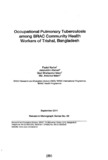| dc.contributor.author | Karim, Fazlul | |
| dc.contributor.author | Islam, Qazi Shafayetul | |
| dc.contributor.author | Islam, Md. Akramul | |
| dc.contributor.author | Ahmed, Jalaluddin | |
| dc.date.accessioned | 2019-12-02T06:57:07Z | |
| dc.date.available | 2019-12-02T06:57:07Z | |
| dc.date.issued | 2011-09 | |
| dc.identifier.citation | Karim, F., Ahmed, J., lslam, Q. S., & Islam, M. A. (2011, September). Occupational Pulmonary Tuberculosis among BRAC Community Health Workers of Trishal, Bangladesh. Research Reports (2011): Health Studies, Vol - XLIII, 180–218. | en_US |
| dc.identifier.uri | http://hdl.handle.net/10361/13169 | |
| dc.description.abstract | Different studies reported 2-14 times higher risk of TB for the healthcare workers
than the general populations. This poses a serious challenge to the healthcare
workers involved in TB control worldwide. BRAG has been using services of
thousands of community-based health workers (GHW) known as shasthya shebikas
for TB control all over the country. Their continuous exposure to infectious pulmonary
TB (PTB) patients might have increased the risk of disease transmission. This
concem led RED to implement a pilot study in Trishal upazila to (i) assess the
operational feasibility of using GXR (chest X-ray) as a tool for PTB diagnosis, and
obtaining and testing sputum samples; and (ii) measure the rate of active TB in
different health workers of BRAG. Data were generated through face-to-face
interview using structured and semi-structured instruments. Each eligible GHW gave
a GXR at a designated private clinic at Trishal. Three independent specialist
physicians examined the GXRs. Besides, three sputum samples (night, moming and
spot) were collected from each of the study participants, and tested at BRAG field
laboratories. Five percent of them were re-tested at an extemal quality assurance
laboratory in Mymensingh for quality control. Additional sputum samples of 26
respondents (two from each) were cultured at the national TB programme reference
laboratory in Dhaka. Positive agreement of two examiners on an individual GXR or
two sputum slides test-positive or one sputum slide test-positive supported by one
GXR-positive or one sputum culture-positive was defined as a TB patient.
Quantitative data were analyzed by SPSS software, while the qualitative data were
handled manually. The estimated prevalence rate of smear-negative PTB among the
shasthya shebikas was 1,612.9/100,000. This was 4-fold higher than the prevalence
of all forms of TB in the general population of Bangladesh. This implies that the
grassroots health workers are at a greater risk of PTB. Qualitative explorations
revealed that contact with PTB patients and poverty were major causes of PTB
among SSs, warranting appropriate measures for preventing disease transmission. | en_US |
| dc.language.iso | en | en_US |
| dc.publisher | BRAC Research and Evaluation Division (RED) | en_US |
| dc.subject | Pulmonary Tuberculosis | en_US |
| dc.subject | BRAC | en_US |
| dc.subject | Community health workers | en_US |
| dc.subject | Trishal | en_US |
| dc.subject.lcsh | Tuberculosis, Pulmonary. | |
| dc.subject.lcsh | Pulmonary Artery -- pathology. | |
| dc.subject.lcsh | Tuberculosis | |
| dc.subject.lcsh | Community health aides/utilization | |
| dc.subject.lcsh | Health, Nutrition, and Population Program (BRAC) | |
| dc.title | Occupational Pulmonary Tuberculosis among BRAC Community Health Workers of Trishal, Bangladesh | en_US |
| dc.type | Research report | en_US |

